|
|
|
Sort Order |
|
|
|
Items / Page
|
|
|
|
|
|
|
| Srl | Item |
| 1 |
ID:
113141


|
|
|
| 2 |
ID:
183085


|
|
|
|
|
| Summary/Abstract |
The building sector could have a high impact on the reduction of GHG emissions. Several countries have developed public policies to encourage Net Zero Energy Buildings (NZEB) as one of the main approaches to reach their GHG reduction goals. Chile has adopted different goals and action plans to reduce fossil fuels and GHG emissions. However, there is a lack of public policies for the building sector. Chile should consider the NZEB an effective measure to reduce GHG emissions because this policy has been successful in other countries, regions, or states because NZEB reduce energy consumption in the building sector and produce energy from renewable sources. This research aims to identify, analyze and compare mandatory public policies of different countries towards NZEB. Different countries' public policies are identified and classified through a literature review based on keywords. Chilean public policies are compared concerning them worldwide. We concluded that Chile has not yet developed public policies to promote NZEB as part of the strategies to achieve its environmental commitments for the coming years. We suggested evaluating the technical potential of buildings to reach NZEB standards in different Chilean climates before elaborating future public policies towards NZEB. It is concluded that Chile has to develop regulatory, economic and information, motivation and advice policies towards NZEB that are the mainstream policies worldwide.
|
|
|
|
|
|
|
|
|
|
|
|
|
|
|
|
| 3 |
ID:
176721


|
|
|
|
|
| Summary/Abstract |
The choice of the most appropriate public policies to foster energy efficiency measures often is a difficult task due to the large number of intervening variables and agents and, also, high levels of uncertainties in estimating the corresponding energy savings. This paper presents a methodology that builds up scenarios to assess the impacts on energy consumption of introducing different levels of penetration of efficient electric induction motors, according to the set of policies and measures adopted in the scenarios. The proposed methodology comprises three modules. The first one selects strategic objectives, key variables and control players, determines their direct and cross-influence levels, based on the opinions of consulted experts, and sets up some scenarios combining them. The second module carries out electric motor sales forecasts based on electricity consumption forecasts for the industry. The third module estimates the energy saving forecasts associated to each scenario. The approach is applied to Brazil in the paper, indicating valuable policy options and their likelihood to local decision makers and other stakeholders.
|
|
|
|
|
|
|
|
|
|
|
|
|
|
|
|
| 4 |
ID:
116914


|
|
|
|
|
| Publication |
2012.
|
| Summary/Abstract |
China promulgated the Medium and Long-Term Development Plan for Renewable Energy in 2007, which included sub-targets of 2010 and 2020 for various renewable energy technologies. Almost all the 2010 sub-targets have been met and even surpassed except non-grain fuel ethanol. There is debate surrounding the questions of whether and how the country will be able to meet the 2020 biofuels target. This paper provides the assessment of potential technology pathways to achieve the 2020 target regarding their respective resource potential and supply cost. Barriers and policy options are identified based on broad literatures review. And an overview of biofuels projections is presented to provide insight into the comparison of various policy scenarios. The study shows that China can potentially satisfy non-grain fuel ethanol target by 2020 from technology perspective. But she will probably fall far short of this target if current situations continue. Additional policy efforts are needed. Meanwhile, the target of biodiesel production has high probability to be achieved. However, if given support policies, it will develop better.
|
|
|
|
|
|
|
|
|
|
|
|
|
|
|
|
| 5 |
ID:
092842


|
|
|
|
|
| Publication |
2009.
|
| Summary/Abstract |
This paper analyses national, regional and international biofuels policies and strategies to assess whether these policies promote or undermine the development of biofuels sector in Africa. Despite having a huge comparative advantage in land, labour and good climatic conditions favourable for the growing of energy crops, few countries in Sub-Saharan Africa have included biofuels strategies in their energy or national development policies. Further results show that while developed countries commit huge financial resources for research, technology development and the provision of tax-incentives to both producers and consumers, there is little government support for promoting biofuels in Africa. Although the consequences of biofuels on food supply remain uncertain, the mandatory blending of biofuels with fossil fuels by industrialized countries will create demand for land in Africa for the growing of energy crops for biofuels. This paper urgently calls upon national governments in Sub-Saharan Africa to develop appropriate strategies and regulatory frameworks to harness the potential economic opportunities from biofuels sector development, while protecting the environment and rural communities from the adverse effects of land alienation from the mainstream agriculture towards the growing of energy crops for biofuels at the expense of traditional food crops.
|
|
|
|
|
|
|
|
|
|
|
|
|
|
|
|
| 6 |
ID:
125728


|
|
|
|
|
| Publication |
2013.
|
| Summary/Abstract |
The power sector in the Kingdom of Saudi Arabia is undergoing the restructuring process. Moreover, during the last decade the Kingdom has witnessed a phenomenal growth in the load demand, consequently a huge amount of generation is added to the electric utilities to meet the load. Up to now only the electric utility generation was taken in the planning of the electrical sector. The data regarding the captive power generation was not readily available. A survey is conducted regarding the captive power generation in Saudi Arabia based on its utilization pattern, fuel used and amount of excess energy available to the grid. The existing regulatory framework and institutional structure of the Saudi power industry was also reviewed. Based on the information collected in the survey of captive power, key guidelines that may be considered in developing the policy for the captive power generators are presented. Furthermore, these guidelines and later the policies will help promote the investors to come forward in developing the captive power generation in Saudi Arabia.
|
|
|
|
|
|
|
|
|
|
|
|
|
|
|
|
| 7 |
ID:
132746


|
|
|
|
|
| Publication |
2014.
|
| Summary/Abstract |
The industrial sector consumes about 50% of the world×s delivered energy and thus has a large impact on the world×s energy production and consumption. Japan is one of the leading countries in industrial efficiency while China is the world×s largest industrial energy consumer. This study analyzes the energy consumption and efficiency of the Japanese and Chinese manufacturing industry. Analysis shows that the energy intensity of both Japanese and Chinese manufacturing industry has decreased significantly. Decomposition analysis shows that the efficiency effect played an important role in reducing energy intensity; improvement of the energy efficiency of both Japanese and Chinese manufacturing industry showed a trend of exponential decay. Structural effect significantly reduced the energy intensity of the Japanese manufacturing industry while having a relatively small influence on the energy intensity of the Chinese manufacturing industry. Our analysis also shows a strong association of industrial energy efficiency improvement with energy policies, highlighting that energy efficiency policies can play an important role in the reduction of industrial energy intensity. The results of this study also underscore the important, yet very challenging, task of achieving structural change to further improve efficiency.
|
|
|
|
|
|
|
|
|
|
|
|
|
|
|
|
| 8 |
ID:
124162


|
|
|
|
|
| Publication |
2013.
|
| Summary/Abstract |
Turkey's Energy Efficiency Law (EEL), enacted in 2007, had been expected to transform the energy policies in government and private sectors, and offer opportunities for, then-impending, Turkish Energy Service Company (ESCO) market. Yet, the communiqué of the EEL related to ESCOs was released only recently in July 2012. In this work, we review the current status of the ESCO market in Turkey. We provide an outlook through the recent legal communiqué and present barriers, enabling factors, and opportunities, supported by country's financial and economic facts. ESCO-financing mechanism prevailing and the sources of financing in the country are also mentioned. The communiqué on ESCOs fits well in the chain of regulatory attempts to increase Turkey's competitiveness in the global markets. However, we anticipate that some of its principles and procedures to be enforced may be deterrent for small-scale candidate ESCOs and may slow down the expected development of the Turkish ESCO market. Otherwise, the communiqué should lead restructuring of a stronger ESCO market in Turkey.
|
|
|
|
|
|
|
|
|
|
|
|
|
|
|
|
| 9 |
ID:
113467


|
|
|
|
|
| Publication |
2012.
|
| Summary/Abstract |
This paper analyses decisions on energy efficiency (EE) investments by small and medium manufacturing enterprises in the US, which have received assessment from the Department of Energy (DoE). The results confirm the importance of payback time and investment costs as the main determining factors in deciding whether to invest in energy efficiency. Such investment recommendations are frequently not implemented even though they apparently entail major advantages and give rise to considerable energy savings. The data show results which are compatible with a series of elementary valuation processes (limited to availability of information), far removed from other, more academically ambitious methods such as Net Present Value (NPV) and the Real Options (RO) method. The paper analyses the impact of the primary resource streams (Electricity, Natural Gas, Other Energy, Waste and Others), physical situation of firms in line with their geographical locations in different US states, and changes over time from 1984 to 2009. EE investment decisions are analysed here using Probit models whose parameters are calibrated on the basis of the information held in the Industrial Assessment Centres (IAC) database. The results suggest various ideas to improve policies for promoting investment in EE, specially the IAC programme.
|
|
|
|
|
|
|
|
|
|
|
|
|
|
|
|
| 10 |
ID:
176674
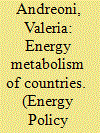

|
|
|
|
|
| Summary/Abstract |
This paper discusses how the deceleration of economic growth, that followed the financial crisis of 2008, influenced the energy efficiency, allocation and use of 18 European countries. By using a Multi-scale Integrated Analysis of Societal and Ecosystem Metabolism (MuSIASEM), the relationships between energy requirements, economic trends and population are investigated for the years 2008 and 2015. The analyses are performed for the entire society (Level N), for the household and the paid sectors (Level N-1) and for the agricultural, the industrial and the service activities (Level N-2). Results show that two main groups of countries performed the largest energy reductions, namely: the country most affected by the global financial crisis, such as Greece, Romania and Spain, where the total energy throughput decreased by −19.6%, −15.8% and −12.1%, respectively; and the countries, such as Ireland and United Kingdom, that experienced the largest energy intensity reductions (−38.7% and −19.2%), together with the highest GDP increases (+44.8% and +10.2%). By providing an overview of the relationships existing between socio-economic and energy variables, this paper contributes to the debate around growth and efficiency and can support the design of policies oriented to promote the achievement of a more sustainable and competitive economy.
|
|
|
|
|
|
|
|
|
|
|
|
|
|
|
|
| 11 |
ID:
136227
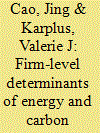

|
|
|
|
|
| Summary/Abstract |
In recent years, China׳s leaders have sought to coordinate official energy intensity reduction targets with new targets for carbon dioxide (CO2) intensity reduction. The Eleventh Five-Year Plan (2006–2010) included for the first time a binding target for energy intensity, while a binding target for CO2 intensity was included later in the Twelfth Five-Year Plan (2011–2015). Using panel data for a sample of industrial firms in China covering 2005 to 2009, we investigate the drivers of energy intensity reduction (measured in terms of direct primary energy use and electricity use) and associated CO2 intensity reduction. Rising electricity prices were associated with decreases in electricity intensity and increases in primary energy intensity, consistent with a substitution effect. Overall, we find that energy intensity reduction by industrial firms during the Eleventh Five-Year Plan translated into more than proportional CO2 intensity reduction because reducing coal use—in direct industrial use as well as in the power sector—was a dominant abatement strategy. If similar dynamics characterize the Twelfth Five-Year Plan (2011–2015), the national 17 percent CO2 intensity reduction target may not be difficult to meet—and the 16 percent energy intensity reduction target may result in significantly greater CO2 intensity reduction.
|
|
|
|
|
|
|
|
|
|
|
|
|
|
|
|
| 12 |
ID:
166995


|
|
|
|
|
| Summary/Abstract |
The production and consumption of energy is the predominant source of air pollution worldwide. Thus, governmental energy control policies may lead to large reductions in air pollutant emissions. Energy policies can be broadly categorized into two types based on their policy goals. First are emission reduction policies, identified as throttling measures, which aim to reduce emissions from the source; second are renewable energy policies, which are dedicated to the development and promotion of renewable energy. This paper employs a spatial econometric method to empirically test the effects of these two types of energy policies on China's emissions of major air pollutants, namely PM10, PM2.5, and SO2, using panel data from 27 provinces and four direct-controlled municipalities over the period from 2003 to 2016. The results offer evidence that provincial emission reduction policies have positive impacts on reduction of PM10, whereas provincial renewable energy policies have positive impacts on the reduction of SO2 and PM2.5. The results also show that energy policies in one province can influence emissions of pollutants in neighbouring provinces due to policy spillover effects. Several policy implications are made based on the research findings.
|
|
|
|
|
|
|
|
|
|
|
|
|
|
|
|
| 13 |
ID:
101493
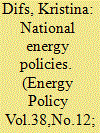

|
|
|
|
|
| Publication |
2010.
|
| Summary/Abstract |
The effect of national energy policies on a local Swedish district heating (DH) system has been studied, regarding the profitability of new investments and the potential for climate change mitigation. The DH system has been optimised regarding three investments: biomass-fuelled CHP (bio CHP), natural gas-fuelled combined cycle CHP (NGCC CHP) and biomass-fuelled heat-only boiler (bio HOB) in two scenarios (with or without national taxes and policy instruments). In both scenarios EU's tradable CO2 emission permits are included. Results from the study show that when national policies are included, the most cost-effective investment option is the bio CHP technology. However, when national taxes and policy instruments are excluded, the DH system containing the NGCC CHP plant has 30% lower system cost than the bio CHP system. Regardless of the scenario and when coal condensing is considered as marginal electricity production, the NGCC CHP has the largest global CO2 reduction potential, about 300 ktonne CO2. However, the CO2 reduction potential is highly dependent on the marginal electricity production. Demonstrated here is that national policies such as tradable green certificates can, when applied to DH systems, contribute to investments that will not fully utilise the DH systems' potential for global CO2 emissions reductions.
|
|
|
|
|
|
|
|
|
|
|
|
|
|
|
|
| 14 |
ID:
155472


|
|
|
|
|
| Summary/Abstract |
This article links two major areas of work on the geographies of oil: socially produced scarcity and the ‘new realities’ of oil, with wider geographical inquiries, mainly global energy governance. It explores how in the current context characterised by oversupply, power stands out as a key factor in the geopolitics of prices, the interactions amongst energy institutions, the role of supply and demand, and the preferences of the actors involved. Geopolitical approaches find a niche in the gaps left by the increasing complexities of global energy governance. In this regard, energy geopolitics may be thought of as ‘governance by other means’, an alternative to failed external energy governance solutions. The article then focuses on the consequences of the drop in oil prices on producer countries and how it will impact the major issues that dominate the literature on energy security. It concludes by stating that there is a need to rethink the geopolitics of energy security in order to incorporate the global governance institutions’ failure to facilitate cooperation as another cause of the re-securitisation of energy policies.
|
|
|
|
|
|
|
|
|
|
|
|
|
|
|
|
| 15 |
ID:
122577
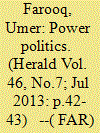

|
|
|
| 16 |
ID:
121034


|
|
|
|
|
| Publication |
2013.
|
| Summary/Abstract |
Actions by individuals and households to reduce carbon-based energy consumption have the potential to change the picture of U.S. energy consumption and carbon dioxide emissions in the near term. To tap this potential, however, energy policies and programs need to replace outmoded assumptions about what drives human behavior; they must integrate insights from the behavioral and social sciences with those from engineering and economics. This integrated approach has thus far only occasionally been implemented. This essay summarizes knowledge from the social sciences and from highly successful energy programs to show what the potential is and how it can be achieved.
|
|
|
|
|
|
|
|
|
|
|
|
|
|
|
|
| 17 |
ID:
177506
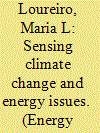

|
|
|
|
|
| Summary/Abstract |
In this paper we assess the sentiments and emotions related to climate change in the U.K. and Spain during the first six months of 2019, and how these relate to different preferences and concerns about energy policies. In doing so, we analyze Twitter messages related to climate change occurring in both countries, using natural language processing (NLP) tools. We find that messages in the U.K. related to climate change are less negative than in Spain; whereas the most evoked feeling in the U.K. (Spain) is anticipation (fear). However, our results show quite similar views about preferences for energy policies in these two Western European countries. In particular, renewable sources of energy are associated with positive perceptions, and coal with negative; whereas heteregoneous preferences are present in the case of nuclear energy. Information of this type may be relevant in order to understand public reactions and preferences towards mitigation and adaptation policies across countries. Our results complement and correspond quite well with those previously published in European surveys. We advocate the use of social media in order to assess sentiment and emotion analysis in close to real time events or manifestation of opinions, not properly covered by official statistics.
|
|
|
|
|
|
|
|
|
|
|
|
|
|
|
|
| 18 |
ID:
175898


|
|
|
|
|
| Summary/Abstract |
We present a power market model that couples short-term electricity markets of five interconnected countries: Switzerland, Austria, Germany, Italy and France. The model simulates the Swiss energy transition. It examines the impact of international (carbon taxation, fuel prices and the expansion of cross-border transmission capacities) and national policies both on short-term operation and long-term evolution of Swiss electricity supply, CO2 emissions, consumer costs and security of supply. The study shows the importance of understanding the interplay of policies and market players to achieve the decarbonization goals effectively. We simulate three national scenarios (Reference, RES+, NUC+), which differ in RES support and nuclear phase-out plans. We compare them along the dimensions of the Energy Trilemma prism: sustainability (CO2 emissions), affordability (costs to the consumer) and security of supply. The Reference scenario results in the highest CO2 emissions. Boosting solar via increased RES support in the RES + scenario reduces CO2 emissions, but increases costs to consumers. NUC + scenario provides the highest CO2 savings potential and the lowest costs to consumers. However, the nuclear extension would need to obtain regulatory or social approval. All scenarios prove a need for a Strategic Reserve to ensure compliance with the legal security of supply criteria.
|
|
|
|
|
|
|
|
|
|
|
|
|
|
|
|
| 19 |
ID:
124208


|
|
|
|
|
| Publication |
2013.
|
| Summary/Abstract |
The goal of this paper is to contribute to understanding the behaviour of the photovoltaic (PV) sector in Spain and its expectations under possible scenarios. Currently, PV solar energy is not a profitable sector by itself. Therefore, the Spanish government, like the governments of other countries, has stimulated investment with subsidies. The spectacular increase of PV facilities exceeded all forecasts and the government decided to curb the trend. The present hypothesis is that continuing with this support to PV energy, the technological advances and the economy generated from the production of panels would be able to make the sector profitable in the future without the necessity of subventions. Based on this hypothesis, a computer simulation model was built using the system dynamics methodology. To test its utility, the model was challenged to fit the historical data and to explore several futures over the next few years. The model allows an understanding of the sector's behaviour under the latest policies of the Spanish government, thus helping to design future public policies. The simulation results are different depending on the adopted policy and the scenario. Therefore, these factors will determine the success or failure of the investments in this type of energy.
|
|
|
|
|
|
|
|
|
|
|
|
|
|
|
|
| 20 |
ID:
166395


|
|
|
|
|
| Summary/Abstract |
This paper examines the impact of climate variability and change (CV&C), and energy policies on the future energy system in Australia. Scenarios were developed to represent CV&C impacts and policy options, which were analysed with the Long-range Energy Alternative and Planning system for the period 2010–2050. The results indicate that although energy demand is likely to increase threefold in the business-as-usual scenario, CV&C further increases demand to 150 petajoule. A combined policy option involving modal shift and penetration of electric and hydrogen fuel cell vehicles results in a 49–53% decrease in transport fuel demand and emissions. The economic analysis reveals a substantial decline in sales revenue and increase in generation costs due to CV&C impacts. Higher renewable energy integration results in lower wholesale electricity prices across independent electricity markets. Cumulative cost-benefit analysis indicates that economic benefits increase to US$4.9 trillion in an advanced renewable energy scenario. Emissions and energy consumed increased under climatic conditions, but decreased after policy intervention. Ignoring the influence of CV&C may result in underestimation of future energy demand and installed capacity in Australia. Therefore, energy and climate policies should consider long-term economic benefits over short-term system costs.
|
|
|
|
|
|
|
|
|
|
|
|
|
|
|
|
|
|
|
|
|